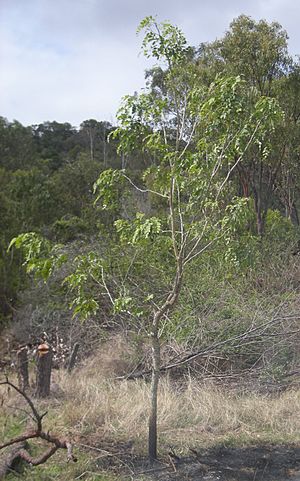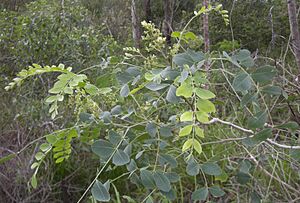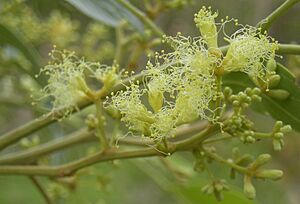Belmont siris facts for kids
Quick facts for kids Belmont siris |
|
|---|---|
 |
|
| Scientific classification | |
| Genus: |
Albizia
|
| Species: |
canescens
|
| Synonyms | |
|
Albizia plurijuga |
|
The Belmont Siris (scientific name: Albizia canescens) is a special type of tree. It is found only in Northern Australia. This tree is known for being tough and useful.
Contents
What is the Belmont Siris Like?
The Belmont Siris looks a bit like its cousin, the Siris tree (Albizia lebbek). However, there are some key differences. The Belmont Siris has a more open top, like a loose umbrella. Its leaves are a dull, grayish-green, not dark green.
Its flowers and seed pods are smaller and less noticeable. The bark of the Belmont Siris is rough and corky. This bark helps it survive fires. The Siris tree, on the other hand, has smoother bark.
How it Grows
This tree can grow in different ways. It can be a tall tree, up to 10 meters (about 33 feet) high. Or, it can grow as a large bush with many stems.
The bush shape often happens after a fire. The plant regrows from its base. This helps the Belmont Siris survive in the eucalypt savannas of Northern Australia. These areas often have natural fires.
Where Does it Live?
The Belmont Siris is found only in Northern Australia. It grows in a wide band across the top of Australia. This area stretches from The Kimberley to Rockhampton in Central Queensland.
You can find it scattered among the eucalypt savannas. It is rarely found in large groups. However, it is common at a research station called "Belmont" in Central Queensland. This is where it gets its common name.
Some people think this tree used to be more common. Its numbers might have gone down because of more fires. Also, new animals brought to Australia might eat too many young trees.
Leaf Drop
The Belmont Siris drops its leaves once a year. This usually happens just before new leaves start to grow. So, the tree is either always green or only without leaves for a very short time.
Its seeds do not last long. They can also be easily damaged by insects.
How People Use the Belmont Siris
The Belmont Siris is not very well known, even in Australia. In the early 1900s, its wood was used to make high-quality furniture. This use has mostly stopped, perhaps because the trees are harder to find now.
However, this tree could still be very useful. It grows quickly, which makes it good for tree farms.
Food and Farming
The Belmont Siris is also great for agroforestry. This means growing trees and crops or livestock together. The leaves and pods of the tree are good food for farm animals.
Even though it produces less food than the Siris tree, animals like it much more. The Belmont Siris also helps nearby grass grow better.
Aboriginal Australians traditionally used the sticky gum from this tree as a food source.



